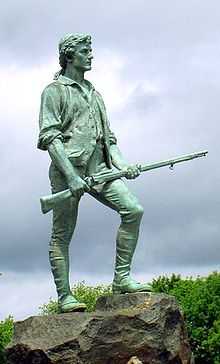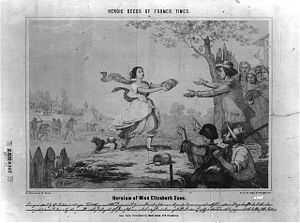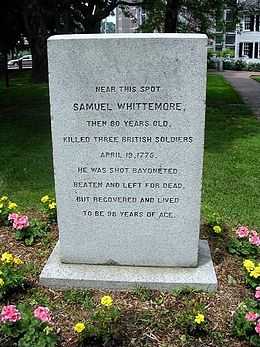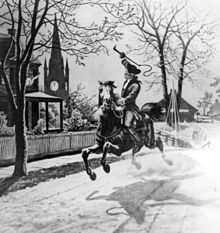Project Appleseed
| Headquarters | Ramseur, North Carolina |
|---|---|
Founder and National Director | Jack Dailey ("Fred") |
| Website | http://appleseedinfo.org] |
Project Appleseed is an apolitical[1] rifle marksmanship training program that focuses on teaching traditional rifle marksmanship from standing, sitting/kneeling, and prone positions over a two day weekend shooting clinic for what is termed an "Appleseed". It is one of the major activities of The Revolutionary War Veterans Association (RWVA), a 501(c)(3) non-profit organization that teaches and promotes traditional rifle marksmanship, while also teaching American heritage and history with the intent of encouraging people to become active civically.[2][3][4]
In addition to Project Appleseed, there is also a companion subsidiary activity conducted within the RWVA called "Liberty Seed" that is the American heritage and history portion of Project Appleseed. "Liberty Seed" has been termed a "civics class in disguise", and features content on the "Three Strikes" that were needed to start the American Revolutionary War.[2]
The emphasis on teaching traditional rifle marksmanship within Project Appleseed centers around traditional rifle marksmanship techniques using a rifle sling coupled with a concept termed "natural point of aim" (NPOA). Project Appleseed uses reduced size scaled silhouette targets that enable a shooter to assess their effective range with their rifle using a reduced length shooting range only 25 meters (82 feet) long, while simulating firing at full size targets at ranges up to 400 yards.[5]
As part of teaching traditional rifleman marksmanship skills, Project Appleseed also teaches the rifleman's cadence. This consists of learning to fire at respiratory pauses every 3–4 seconds, shooting in synchronicity with one's natural rhythm of breathing thereby enabling improving one's marksmanship.[6]
Some commentators have questioned the political aspect of the self-empowerment of shooting.[7]
History

Project Appleseed started from a series of ads that became ads with monthly columns appearing in Shotgun News, a monthly gun trade newspaper publication. These ads were written under a pseudonym by a fellow who simply called himself "Fred". "Fred," the founder of Project Appleseed, whose real name is Jack Dailey, has been writing a column—actually a portion of ad space for Fred's M14 Stocks—since 1999.[8] A common theme in these columns is "Are you a cook or a rifleman?", a "cook" being Fred's term for an unqualified rifleman. The name of the project was in deference to Johnny Appleseed, an American pioneer nurseryman and grass roots missionary who traveled the American frontier planting apple trees across the land with the goal of spreading the number of apple trees in America; Fred's goal was to accomplish the same with civic-minded Riflemen in America. Project Appleseed itself began in April 2006 in Ramseur, North Carolina.[4]
In 2006, Appleseed instructors began a national tour to attract new instructors who could maintain and develop local programs.[9] In 2008, Appleseed had nearly 4,000 attendees. In 2009, there were more than 450 scheduled Appleseed events that taught 10,000 shooters. In 2010, 32,000 had been taught to shoot by the end of the year.[8] In 2012, there were over 1,000 Appleseeds held, by which time over 40,000 shooters had been taught. In addition, a select cadre of Appleseed instructors from across the nation gathered at Fort Stewart, GA and taught a deploying Army unit in marksmanship skills in 2012. By late 2014, over 75,000 shooters had been taught.
Oral histories


An Appleseed contains breaks during which oral histories are told of the events leading up to the American Revolution, specifically the Battles of Lexington and Concord, and the subsequent British retreat to Boston. Also told are the Three Strikes of the Match, of the 3 events along Battle Road that had to occur prior to the Revolutionary War flaming into a full-out war.[2] These oral histories include an overview of the events of April 18–20, 1775 but focus on stories of individuals such as Paul Revere, Dr. Samuel Prescott, and William Dawes; Captains John Parker (Lexington), Isaac Davis (Acton), and Hezekiah Wyman; Elizabeth Zane; and octogenarian Samuel Whittemore, the oldest known colonial combatant in the American Revolutionary War.[1][4] Stories of Daniel Morgan and his Morgan's Riflemen are also told. Known Distance Appleseeds often add stories featuring Patrick Ferguson and Timothy Murphy, who were riflemen that played major roles at the Battle of Brandywine, Second Battle of Saratoga, and the Battle of Kings Mountain.



Safety rules (AS is Always Safe)
Appleseed marksmanship clinics provide these 4 Rules:[10]
- Always keep the muzzle in a safe direction.
- Do not load until given the load command.
- Keep your finger off the trigger until the sights are on the target.
- Make sure those around you follow the safety rules.
These are similar to other gun safety rules and recommendations.[10]
Marksmanship goals

The ultimate goal of the rifle marksmanship clinics known as "Appleseeds" is to teach students the ability to maintain a 4 minutes of angle (MOA) precision and accuracy when shooting through the use of traditional sling-stabilized United States Army shooting techniques, using a rack-grade rifle with iron sights. This translates into becoming a rifleman, defined as: a "marksman capable of hitting a man-sized target from 500 yards away."[11] A 4 MOA precision and accuracy translate into being able to put all rounds into a circle with a diameter of 20 inches at 500 yards, equaling the center of mass of a human. At 25 meters, this same 4 MOA precision and accuracy translate into firing rounds accurately into a circle of approximately 1 inch diameter.
Two elements are fundamental to Appleseed rifle clinics: the Six Steps to Firing a Shot and natural point of aim (NPOA). The six steps, as taught by the Appleseed Project, include:[6][10]
- Sight alignment
- Sight picture
- Respiratory pause
- Focus
- Focus your eye on the front sight
- Focus your mind on keeping the front sight on the target
- Squeeze the trigger
- Follow through
- Hold the trigger back
- Call your shot
Detailed instruction by instructors on each of these steps is taught to all attendees as a group with additional one-on-one instruction as necessary.[12]
Natural point of aim is a firing technique that does not rely on the shooter's muscles to aim the rifle. Using a sling, a relaxed body, and the NPOA technique, a rifleman can consistently shoot 4 MOA groups at 500 yards.[6]
Demonstrating the ability to achieve a 4 MOA accuracy and precision requires achieving a score of 210 or higher on an adapted ("Quick and Dirty") Army Qualification Test (AQT), now termed an Appleseed Qualification Test (AQT), out of a possible 250 points. The AQT uses timed stages to test shooting skill from standing, sitting, and prone positions. The test simulates ranges of 100, 200, 300, and 400 yards. The 400-yard simulated target is approximately 6.25 square centimeters (about one square inch), and is shot at a range of 25 meters. This translates into a 4 MOA wide target which is the rifleman standard in the Appleseed program.[10]
The adapted AQT target requires 40 rounds, 10 for each stage, where:
- Stage 1 (single silhouette; 10 rounds) is fired standing in 2 minutes, from a single magazine
- Stage 2 (two silhouettes; 5 rounds and 5 rounds) is fired after transitioning from standing-to-sitting/kneeling with a magazine change and one NPOA shift in 55 seconds
- Stage 3 (three silhouettes; 3 rounds, 3 rounds, 4 rounds) is fired after transitioning from standing-to-prone with a magazine change and two NPOA shifts in 65 seconds
- Stage 4 (four silhouettes; 2 rounds, 2 rounds, 3 rounds, 3 rounds) is fired staying in prone from a single magazine in 5 minutes, slow-fire, with three NPOA shifts
For the stages requiring a magazine change, stages two and three, two magazines are loaded with 2 and 8 rounds, respectively. (The choice of 2 rounds and 8 rounds is based on the historical practice followed with the M1 Garand, with its 8 round en-bloc clip.) The Appleseed targets contain a "V", analogous to the "X" seen on military targets that is used to serve for breaking ties when shooting competitively for score when all hits are in the black on the target.
Shooters who score 210 or better on the "Quick and Dirty" Appleseed AQT earn the Rifleman designation and are issued a Rifleman patch.[10] Upon shooting a Rifleman score twice, participants are eligible to enter the Instructor In Training (IIT) program to teach marksmanship skills to others. Instructors must re-qualify periodically to remain instructors.
Similar to the U.S. military marksmanship ratings of Unqualified, Marksman, Sharpshooter, and Expert (see Marksmanship Badge (United States), the Appleseed ratings have the same levels, with the exception that instead of "Expert", the equivalent performance level is called "Rifleman".[10]
Shooters earning the Rifleman patch also become eligible to participate in Known Distance (KD) Appleseed shoots, on full-size (un-scaled AQT targets) placed at 100, 200, 300, and 400 yards. Such Appleseeds enable shooters to hone their skills further at actual distance, adding in the additional complications of accounting for changing bullet drop vs. distance, as well as for accounting for wind. KD Appleseeds are always done with centerfire rifles. The ultimate goal of achieving a precision and accuracy of 4 MOA is roughly equivalent to becoming competent enough to hit a man-sized target consistently at the so-called Rifleman's Quarter Mile of 440 yards.
The choice of selecting a 25 meter range for commencing in Project Appleseed stems from several factors. First, most rifles are zeroed at 25 meters to make them ready for use at distances up to the point blank range of the rifle, regardless of rifle. Zeroing a rifle at 25 meters, and becoming proficient with it, therefore readies the rifle for the majority of common uses. Second, there is an established USMC practice of training long range shooters using a 1,000-inch range to practice long range shooting basics independent of environmental and bullet effects, through shooting at reduced scale targets, thereby allowing a shooter to focus solely on Rifleman techniques without having to account additionally for wind, bullet shape details (boattail, etc.), ballistic coefficients, elevation offsets, altitude effects, and similar details.[13] A 1,000-inch range exactly equals 25.4 meters, which rounded to two-digits is precisely 25 meters, the exact distance that Appleseed clinics first focus upon. After practicing at reduced scale targets on a 1,000-inch range, the USMC practice is to then transition trained riflemen to a 1,000 yard range, where mitigating techniques required for accounting for secondary effects are taught with the knowledge that the Rifleman fundamentals were made solid at the 1,000-inch range. The skills from Appleseed, shooting scaled targets representing distances up to 400 yards, can therefore provide a foundation of training civilians or military personnel for transitioning to CMP shooting out to distances of 600 yards, to NRA-sponsored National Rifle Matches at Camp Perry shooting out to varying distances, to Wimbledon Cup and F-Class shooting out to distances of 1000-yards, or to even greater ranges, for a variety of shooting sports, by simply reducing the scale of the targets used at an actual distance of 25 meters.
After shooting at an Appleseed over a 25 meter range, a .30-caliber or similar full-power cartridge rifle, or a 5.56mm (.223) intermediate-power cartridge rifle is essentially ready for real use in most circumstances, with only slight differences needing to be accounted for to reach out up to 400-500 yards.
Clinics and boot camps
Project Appleseed uses two paths for teaching traditional rifleman marksmanship skills. The path most commonly taught is a two day shooting clinic that is taught over a weekend for what is termed an "Appleseed'. Less common, but available for those wishing to learn rifleman skills more quickly in a more intense setting, is a weeklong Rifleman's Boot Camp, that then terminates into a two day Appleseed.
Most commonly, .22 Long Rifle cartridges are used, especially initially, since the ammunition is inexpensive and recoil is negligible - factors that bear consideration in the face of two or more days of very intense shooting practice, firing 500+ rounds.[10] A magazine-fed, semi-automatic rifle with quality iron peep sights and a military loop sling is what is most commonly used; example rifles are the Ruger 10/22 and the Marlin 795.[10] The unofficial preferred rifle is a so-called "Liberty Training Rifle" (LTR), consisting of a Ruger 10/22 with military-style aftermarket sights made by Tech-Sights, and an inexpensive military-style web sling.[10] Tube-fed magazine rifles, such as the Marlin Model 60, can be used, but are not as amenable to learning all the skills that are taught since they do not have removable magazines, and the action of changing out a magazine has to be simulated. Some participants prefer to use a telescopic sight if their eyes are not able to work well with iron sights.[10] Appleseed shooting clinics require approximately 500+ rounds of ammunition for the two-day course.[5][10] The skill sets that are taught include shooting from standing, sitting/kneeling, and prone (flat on the ground) positions, as well as shooting after transitioning from standing to sitting/kneeling, and after transitioning from standing to prone, all of which are shot with time limits. Rifles are generally never loaded when transitioning from standing to either sitting or prone positions, in keeping with the 4 Rules, except when doing a 4 Minute AQT containing transitions from standing to sitting and from sitting to prone, during which times the rifle's safety is engaged. Extensive use of the loop sling is made for accuracy, and multiple sling techniques/positions are taught (e.g., hasty-loop two-point sling, hasty-hasty two point sling, single point loop sling, high-loop sling, etc.). These sling positions are variously suitable for shooting accurately either quickly or slowly, over low/medium/high ground cover, among standing/sitting/kneeling/prone positions, as situations merit. Different techniques for shooting off-hand are also taught, dependent on the style of stock on one's rifle (e.g., using a high "chicken-wing" technique with a straight rifle stock vs. using a low "chicken-wing" technique with a pistol-grip rifle stock).
The first day of shooting of an Appleseed focuses on shooting at a known fixed distance, only. The second day adds lecture details on shooting at varying distances, and shooting in wind, although shooting at varying distances is not always practiced. Some Appleseeds, however, are shot at real distances on day two, or at both 25 meters and 100 meters on day two, depending on specific shooting range facility limitations. For these Appleseeds, the typical progression is shooting at 25 meters only on day 1 with a .22, then shooting at varying distances on day two with a .30-caliber or other center-fire service-type rifle (5.56mm, etc.), or shooting at 25 meters and then at 100 meters with a .22 for part of day two for those students demonstrating an ability to maintain 4 MOA accuracy. Oral history stories regarding individuals involved at the outbreak of the Revolutionary War, such as Paul Revere, as well as the "Three Strikes" that were needed to start the American Revolutionary War, are discussed during breaks in the shooting activities. Stories regarding the role of marksmanship during the retreat on April 19, 1775, are also told.[2]
Known Distance (KD) Appleseed Rifle Marksmanship clinics are also held separately for advanced students and instructors. These require center fire rifles only, and typically are started with initial sighting-in being done at 25 meters for setting Battle Sight Zeroes, followed by shooting at known distances of 100, 200, 300, and 400 yards, as a minimum. Where ranges physically can allow shooting further, students are also usually given an opportunity to shoot at 500 yards, 600 yards, and even longer distances, for determining precise data on personal equipment (DOPE), out to the limits of the particular range where the KD Appleseed is being held. The usual course of study is a classroom lecture for half of the first day, covering intermediate to advanced topics related to ranging, come-ups, mitigating wind, and related topics, followed by shooting sighters at 25 meters, and again at all distances that will be shot. Although most KD Appleseeds are 2 days in length, some KD Appleseeds are continued into a third day, during which time "Top Shot" and similar contests are held, consisting of target detection, followed by ranging the unknown distances to the detected targets, and, finally, shooting for score onto the targets. All instructors, despite having repeatedly previously shot a Rifleman score, equivalent to Expert on the old Army Qualification Test, are additionally required to re-qualify at least annually, in terms of shooting repeat Rifleman scores, at both short and long distances. KD Appleseeds are usually held only once or twice a year in each state, whereas regular Appleseeds typically are held several times a month in most states.
Upon completion of an Appleseed shooting clinic, or a Rifleman's Boot Camp, participants receive a signed certificate from the Revolutionary War Veterans Association, a CMP affiliated club,[14] establishing participant eligibility to purchase a military rifle through the Civilian Marksmanship Program, and to have a rifle and/or ammunition shipped to their door, provided they are not legally barred from owning firearms. The CMP is run by the Corporation for the Promotion of Rifle Practice and Firearms Safety (CPRPFS), a not-for-profit corporation chartered by the United States Congress in 1996 to instruct citizens in marksmanship and promote practice and safety in the use of firearms.[15] The group holds a congressional charter under Title 36 of the United States Code. From 1903 to 1996, the CMP was sponsored by the Office of the Director of Civilian Marksmanship (DCM), a position first within the Department of War and later in the Department of the Army. Many of the rifles acquired through the CMP by prior Appleseed attendees, such as the M1 Garand battle rifle that was used from World War II through Viet Nam, are then used by prior Appleseed attendees for KD Appleseeds, which require a center fire rifle. These rifles are also often used for CMP competition matches by former Appleseed attendees.
Adaptive Appleseed
The standard shooting positions taught in an Appleseed rifle marksmanship clinic include standing, seated and kneeling, and prone. However, for any individuals who cannot physically perform one or more of these positions, Adaptive Appleseed exists. Such Adaptive Appleseed shooters can still participate in an Appleseed by shooting from a wheelchair, or from a wheelchair near a bench, or with any other necessary accommodations, depending on their personal abilities. Similarly, for younger children who are not ready for transitioning from standing to seated or from standing to prone with a rifle, they may instead shoot entirely from the prone position, using a small portable stand that limits the maximum arc their rifle can be moved. Many shooters regularly shoot to Rifleman standards, equivalent to Expert on the Appleseed Qualification Test (AQT), from a wheelchair, including those that are single and even double amputees. All Appleseeds welcome Adaptive Appleseed shooters.
Criticism
In 2009, the Anti-Defamation League classified Project Appleseed as part of a trend in which idealistic concepts of armed resistance have "percolated beyond extremist groups and movements into the mainstream", but did not classify Project Appleseed as being an extremist group.[8] Sociologist James William Gibson, classifies Project Appleseed within a broader movement that is unlikely to pose a danger to civil society, stating: "When a culture is in crisis, the first response is often to go back to the creation myth and start over again. The narrative is "we’re going to redo the narrative of the United States by returning to origins, to marksmanship". People are focusing on the idea that America’s problems can be resolved into something that can be shot. It doesn’t exactly encourage systematic reflection, but it’s a long ways from a civil war."[8]
See also
- Civilian Marksmanship Program
- National Rifle Association
- Designated marksman
- High Power Rifle
- Marksmanship Badge (United States)
- Shooting sport
- Stinson, West Virginia
- Wimbledon Cup
Notes and references
- ↑ 1.0 1.1 Zak, Dan (April 12, 2010). "Appleseed Project teaches marksmanship and history, hopes to improve the country". Washington Post. Retrieved May 1, 2013.
He points me out, so everyone knows there is a reporter present from the mainstream media, and emphasizes that the project is apolitical, that personal ideology has nothing to do with history or marksmanship.
- ↑ 2.0 2.1 2.2 2.3 Westfall, Sabrina (April 12, 2013). ""Liberty Seed" history presentation coming to 4-H fairgrounds Monday". Greene County Daily World. Retrieved April 22, 2013.
- ↑ Butler, B: Learning Marksmanship a blast at Appleseed event, The Journal (Johnson Co., Indiana), August 27, 2008
- ↑ 4.0 4.1 4.2 Rhodes, S (February 2008). "The Appleseed Project - Turning America Back Into a Nation of Riflemen" (PDF). SWAT Magazine.
- ↑ 5.0 5.1 "Project Appleseed". Hernando Today. April 19, 2013. Retrieved April 22, 2013.
- ↑ 6.0 6.1 6.2 Adcock, Juli (March 30, 2012). "Parallels in Rifle Marksmanship and Law Enforcement". Law Enforcement Today.
- ↑ Schwartz, Mattathias (2010-07-29). Firing Line. New York Times. Retrieved on 2014-07-03.
- ↑ 8.0 8.1 8.2 8.3 Schwartz, Mattathias. "Firing Line". The New York Times. Retrieved 11 April 2013.
- ↑ Nesbitt, J: Gunning for tradition - Event hopes to keep rifle skills in focus, Evansville Courier & Press, April 30, 2006
- ↑ 10.0 10.1 10.2 10.3 10.4 10.5 10.6 10.7 10.8 10.9 10.10 Ayoob, Massad (May–June 2010). "The Appleseed Project" (123). Backwoods Home Magazine.
The most popular Appleseed rifle by far, nationwide and certainly at the shoot I attended, is the Ruger 10/22 semiautomatic. Fitted with a 10 or 12 dollar fabric loop sling, which when properly secured to the upper part of the support arm steadies the rifle in virtually any shooting position, and with a Garand-like adjustable aperture sight from Tech-Sight (www.tech-sights.com), you have the LTR, or Liberty Training Rifle, the "unofficial official gun" of Appleseed. Telescopic sights are allowed, and are a definite benefit to those of us with older eyes.
- ↑ Codrea, David (August 2008). "To Plant a Seed". GUNS Magazine.
- ↑ "Participants learn about history and rifle marksmanship in Project Appleseed event". 3 KRTV, Great Falls and North Central Montana. April 14, 2013. Retrieved April 22, 2013.
- ↑ Henderson, Charles W. (2003). Silent Warrior (2003 ed.). Berkley Books. ISBN 978-0-425-18864-4.
- ↑ "Civilian Marksmanship Sales". Retrieved 2013-04-24.
- ↑ Pub.L. 104–106, 36 Stat. 5502, enacted February 10, 1996